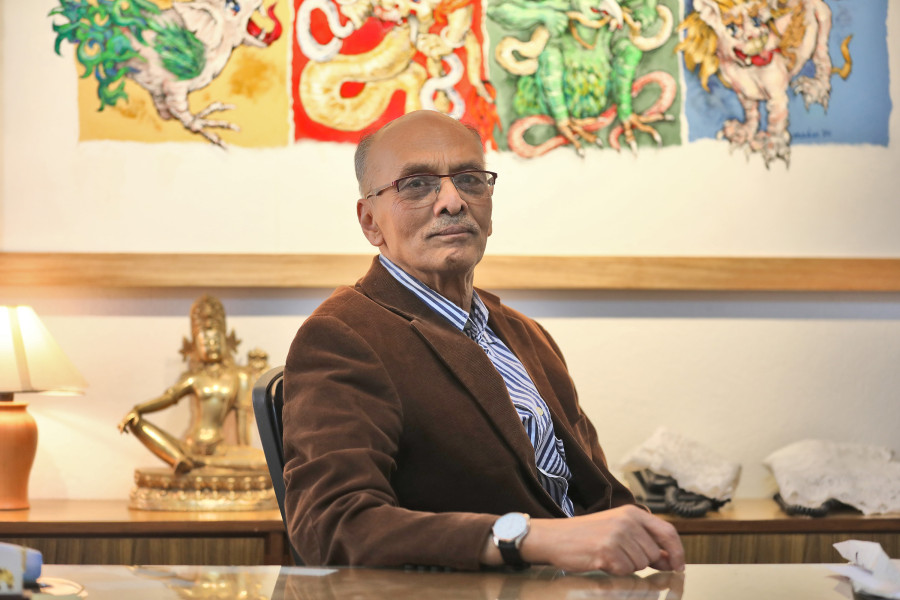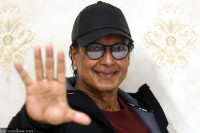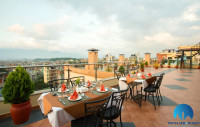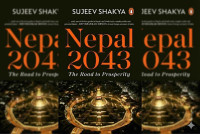Culture & Lifestyle
‘If words don’t support your art, your work will make no mark’
Madan Chitrakar has been writing about art for 45 years. In his seventies now, he is one of the most vocal proponents of the importance of art writing.
Srizu Bajracharya
There’s just so much to talk about with Madan Chitrakar, the veteran artist/art writer. Chitrakar has so many stories to tell of the art world. From the development of art in the country to where Nepal’s art scene is heading, the 74-year-old has a lot to share. Chitrakar, perhaps, is one of the key persons today to discuss art critically.
At his home in Tyeuda near Ason, Chitrakar spends his afternoons writing and documenting Nepal’s art history. His studio is filled with art literature, awards and recognitions he has received and paintings by his father Tej Bahadur Chitrakar who built the foundation of contemporary art in Nepal in the early 20th century.
Through the years, Chitrakar has created his own identity, different from that of his father. Besides making and teaching art, he devotes a lot of his time to art writing. Recently, Chitrakar launched his book ‘Nepali Art Thoughts and Musings’, a collection of his essays about Nepali art, the shifting art trends and stories of artists.
In this conversation with the Post’s Srizu Bajracharya, Chitrakar talks about his journey of art, learnings from his father and why he considers art writing significant for the development of art. Excerpts:
How did your art journey start? What did your childhood look like?
Since my father was very much into art, my childhood was surrounded by art. I grew up understanding art through him and the many people who came to learn from him. I started scribbling with charcoal on paper from a young age. My father also used to teach art at Juddha Kala Pathshala, and whenever I had time, I used to visit the art school to meet him and other times just to enjoy the art events.
But I think my journey as an artist took off when I went to Sir JJ Institute of Applied Art in Mumbai, then Bombay, to pursue my higher education. I took formal classes for graphic communication, a practice applied for social uses, and I think I was one of the first from Nepal to take that course. Thanks to my father, I always had an aesthetic understanding of art and artistic skill, but it was in Bombay that I think I got an opportunity to fine-tune myself, explore and learn more. My stay in Bombay was very fruitful and I think it was a turning point for me.
You said your father groomed you—did it entail sitting down and learning with him or was it a more informal exchange of knowledge?
All the learnings from him happened unknowingly—he never intentionally sat down with me to teach me, nor did I approach him to learn from him. When growing up, I admired my father a lot, I looked up to him but I never saw him as a renowned artist. To me, he was just my father. That realisation that he was a great artist came much, much later.
But our old house from the very beginning was a learning place for many artists—my father built a foundation of teaching art right from his home, providing his expertise to artists to become their best. It might sound like I am bragging but this is all true. Iconic artists like Amar Chitrakar and Dil Bahadur Chitrakar used to come to our home to learn art. The two senior artists would spend a lot of time at our house working on their artworks. Seeing them work on their art, I started working on my art as well. I used to show my works to them. In the beginning, I think I never showed my work to my father. I didn’t have that courage in me.
Then when I was in grade 8, I finally mustered enough courage to share my works with baa. I remember those days clearly. He used to smoke tambaku and with just his fingers pointed towards the art, he would tell me the techniques of colour, light and shadow. He, however, never double worked on my art; he just guided me, and the small tips he gave me have always stayed with me. His learnings still echo through my mind.
As a son of a great artist did you ever worry about being compared to him?
I never really thought about being compared to my father and hence never felt that burden. I think it's because we both pursued different genres of art.
Yes, definitely, when you learn from someone under their shadow, you will see a heavy influence of that person in your work. But from the very beginning, I think I was very conscious of that.
While I was heavily influenced by his idea during my early days of making art, I was always resolute with the idea that I need to create my own identity. I didn’t want anyone’s influence to show in my works. I learned the fundamentals from them but I believed as an artist, the exploration part was for me to discover.
How did you get into art writing?
Since I was a young boy, I was always aware that art needs to be supported by words. I think I was also quite inspired by Satya Mohan Joshi sir, who valued writing. And I have always seen writing as a powerful tool. And when I was working at the Ministry of Tourism, I penned a lot of articles but I also used to think to myself why I was writing about tourism when I could write about art—where there is a lot left to write about.
But the journey of writing began when Manuj Babu Mishra, a prominent artist, and I started to talk about pursuing an MA degree. At the time, my idea was to study Political Science or English Literature. But I remember him telling me, ‘You are a person who has a background in art, you should write art history—so you should go for Ancient History and Culture.’ And then we sat for the exam together and that was it. Taking Ancient History and Culture pulled me closer to understanding art.
You see, when you study art, history and architecture, you get pulled into this excitement to know more, you yearn to investigate. So, after completing my Masters in 1974, I went on to explore my interests and by 1976 I was writing about art. I remember one of my first articles about the sun god was very complex—it used a lot of compound words. It was childish of me to do that. I think the general people would not have understood it.
When I went to The Rising Nepal office, the editor said I have used very complex words in my article and people will not be able to understand it. And he was the one who said, “think of the audience when you are writing”. That was how my writing journey began. I believe if words don’t support your art, your work will make no mark. And till today, my thirst for reading and writing has not waned. But given time, I would like to paint more. And I would be happy to see more art writers thrive.
How do you think Nepal’s art scene has changed?
Oh my god! I think it’s been a hell of a change. When I was a young boy as I tagged along with my father to his meetings and conversations, I remember how there was a socio-cultural movement of art going on. After the democracy of 1951, there was a movement of artists towards building institutions for formal learning, not just in regards to art but literature.
Later, when my father was the vice-chairman of Nepal Kala Samittee, he along with great literary figures of the time like Chittadhar Hridaya, Satya Mohan Joshi, Chandra Man Singh Maskey, artists like Mano Vajra Bajracharya, and my father’s students Amar Chitrakar, Kul Man Singh Bhandari were all working towards institutionalising art learning. Their challenges were different from ours. They were trying to lay the foundation.
The art scene in the country today however is thriving—Kathmandu as an art city has developed so much. There are so many activities of art happening simultaneously—if something is happening at Sirjana, there is something else happening at Bhrikuti Mandap or Siddhartha Art Gallery. When I was in Bombay, I used to hope to see a Kathmandu where there are multiple art activities being held. That thought felt too far-off at the time. But that’s happening now.
Today, there is no comparison to what art can be. The sky's the limit—you have traditional art, improvised traditional art, modern art, space art to installation arts. People have learned to do all kinds of art—artists have been able to play with multiple art forms. And we should be proud of it. I think we are moving forward with art development.
But do you also see where we have missed working in the art development of the country?
Yes, although we have come a long way, there’s definitely so much that hasn’t happened yet for the art development. Though there were so many efforts for art education, there are big lapses in the art development.
Nepal as a nation still does not have the needed infrastructure for art development. We only have one art council, and if we didn’t even have that, there would have been no place to exhibit our works on a national platform. Now compare our development to that of Bangladesh who got liberation in 1971, and look at their love for art and their achievement. Their art complex and galleries make me feel sad for ourselves. Every two years they organise art biennales, they celebrate art with so much importance. But why haven’t we been able to do the same? That’s because we have never imagined such goals and never had the willpower to do such things.
I think all this is because as a country we have not been able to build a culture of meritocracy—what I mean to say is we don’t see the right person in the right job, we don’t see the visionary people we need in the right places. And it's because of that there has not been enough interventions towards developing art from the government side. We don’t have enough people who can bring change in the system. I am, however, talking collectively. If we had these hardwares, we would have been able to organise international art forums and do so much.
Now coming back to your book, what was the idea behind it? Where did the concept of the piece originate?
It’s important that art is documented in a book form. I write stray articles sometimes just for myself and sometimes when people ask me. I used to write for Spaces and Praxis magazines and their focus was on bringing concurrent discussions about art and architecture, even engineering.
But my hidden agenda about writing has always been to introduce art to the Nepali people. Plus concurrent ideas and discourse on art can be fleeting and I have always been conscious about that.
So, I used to work on writing articles that have long-term value. Because I believe if they were to be compiled together they could provide a good understanding about Nepali art. That’s how I began writing intently and it went on. My first book of compiled articles was ‘Nepali Art: Issues Miscellany’ in 2012 and people loved that collection.
But I have also always wanted to bring out books in a systematic chronological order and so I wrote ‘Tej Bahadur Chitrakar: Icon of a Transition’. However, I have always continued writing and so I wanted to bring together another collection of my essays.
People have come up to me and said that I should write a whole book instead of coming up with collections of articles. But a collection of articles compiled together in a book can give people information and a wild idea of art. And this is the second part to ‘Nepali Art: Issues Miscellany’ and this time it's called ‘Thoughts and Musings’. I think, for the time being, this will be a handy book for people who want to know about artists and art practices.
But I do believe we need to bring a book that can build a narrative of Nepali art. That is something we still need. And that is what I would like to work on too. But writing takes a lot of time and effort. And I am a man in a hurry. My bottom line has been—whatever I know I should share.




 12.12°C Kathmandu
12.12°C Kathmandu















